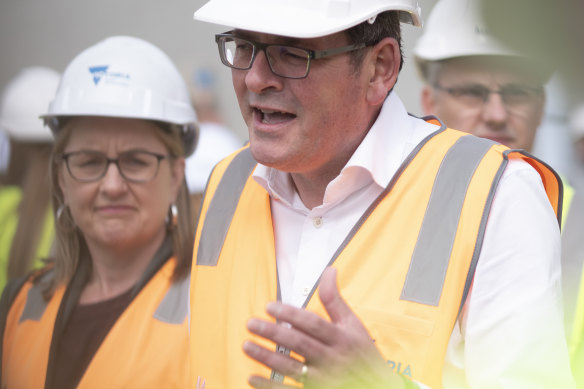- Exclusive
- Politics
- Victoria
- Public housing
The Victorian social housing projects that have quietly lost funding
By Rachel Eddie
Hundreds of new social homes to be built on Crown land have been left without funding after the Victorian government quietly removed 15 projects from its Big Housing Build scheme to cut costs.
The 2020 promise to build 12,000 social and affordable homes over four years under the $5.3 billion plan is three years behind schedule – and savings have been found to keep it on budget as construction costs rise.

Then-premier Daniel Andrews, with then-deputy Jacinta Allan, releasing the housing statement in September last year.Credit: Elke Meitzel
In May last year, the state government “deferred” 15 projects that will no longer be built on state-owned land under the program, a leaked government document obtained by The Age and a report from the Victorian Auditor-General’s Office show.
While the same number of homes will be built as part of the scheme, fewer will be constructed by the state on government land to keep within budget.
The Allan government said the 15 projects had not been dumped, as it was seeking funding from other streams and the Commonwealth, adding it was common for projects to move between programs.
Opposition housing spokesman Richard Riordan said the state government must have known since before the last election that the program could not be delivered as planned, given the auditor-general said agency Homes Victoria raised budget concerns in October 2022.
One of the 15 projects – 50 homes on Pound Road in Colac – will instead be funded under a $1 billion regional housing fund that was promised to make up for the cancellation of the 2026 Commonwealth Games.
The Colac project was publicly announced by then-premier Daniel Andrews as part of the September housing statement – months after the government approved its deferral under the Big Housing Build.
However, funding for the remaining 14 projects encompassing more than 1200 houses – including 445 social homes, 447 affordable homes and 361 private homes – is uncertain.
According to the leaked Homes Victoria document, the deferred projects include housing on Railway Parade in Murrumbeena; Rosstown Road in Carnegie; Miller Street in Preston; Pickett Crescent in Belmont; Power Street in Williamstown; the Victoria University campus in St Albans; High Street, Melton; McKenzie Street in Echuca; Dawes Road in Kyabram; McDonalds Road in Epping; Maralinga Avenue in Keysborough; Main Street, Bacchus Marsh; and McGregor Road in Pakenham
The list also includes the Fitzroy Gasworks, which has been promised since 2018.
“These projects have not been dumped,” a Homes Victoria spokeswoman said.
“All of these projects are at different stages in delivery or development, with some being considered for Commonwealth funding from the Housing Australia Future Fund.”
The first round of successful applications under the Commonwealth’s Housing Australia Future Fund and National Housing Accord will be announced soon and the Social Housing Accelerator fund will build another 769 homes in Victoria.
It means the deferred homes could ultimately be built on top of the Big Housing Build, although the state government cannot confirm how they will be funded.
To make savings to the Big Housing Build, a total of 1551 fewer social homes will be built on land already owned by Homes Victoria and other government agencies.
Community housing providers will build more social homes and more affordable housing to make up for the shortfall – both of which cost the government less.
“As the auditor-general made clear, the Big Housing Build will deliver the same number of homes as promised by the government within budget,” the Homes Victoria spokeswoman said.
Public housing rent is 25 per cent of gross household income, while community housing can be 25 to 30 per cent. Affordable housing rent is set 10 per cent below the market rate in metropolitan Melbourne, but at the market rate in the regions. It is also capped at no more than 30 per cent of the median income of metropolitan Melbourne or of regional Victoria depending on its location.
The Colac project originally promised 50 public homes, but after receiving feedback, Homes Victoria said the site would deliver 30 social and 20 affordable homes and that another 20 social homes would be built elsewhere in Colac.
Riordan questioned whether the program was more focused on maintenance and renovations than new constructions. The auditor-general said the number of social homes in Victoria has “remained broadly steady” between 86,318 and 88,189 from 2017 to 2023.
“The Allan government has made the housing crisis worse by not delivering extra homes,” Riordan said.
Just 3 per cent of homes were social housing in 2023, below the nationwide average of 4.5 per cent. The auditor-general said Victoria would need to build an extra 22,000 by 2036 to maintain current levels relative to population growth.
Housing Minister Harriet Shing told journalists on Sunday the government had spent about half of the $5.3 billion to expand and improve social housing stock under the Big Housing Build.
“We’ve seen 9600 homes either completed or under way, and we’re determined to continue that work, including in partnership with the Commonwealth,” she said.
Get the day’s breaking news, entertainment ideas and a long read to enjoy. Sign up to receive our Evening Edition newsletter.
clarification
This article has been updated to make clear the definition of affordable housing.